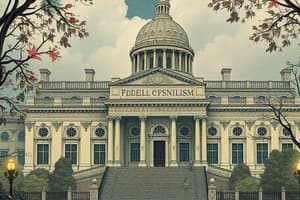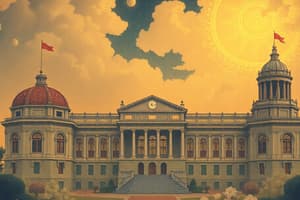Podcast
Questions and Answers
How did the structure of government under the Articles of Confederation contribute to its ineffectiveness?
How did the structure of government under the Articles of Confederation contribute to its ineffectiveness?
It lacked a strong central authority, leading to disunity and an inability to enforce laws effectively.
Explain how Shays' Rebellion exposed critical weaknesses within the Articles of Confederation.
Explain how Shays' Rebellion exposed critical weaknesses within the Articles of Confederation.
It revealed the government's inability to effectively suppress domestic uprisings due to lack of centralized military power.
How did the views of Washington and Jefferson differ regarding the immediate aftermath and significance of Shays' Rebellion?
How did the views of Washington and Jefferson differ regarding the immediate aftermath and significance of Shays' Rebellion?
Washington was more alarmed by the rebellion, viewing it as a sign of anarchy, while Jefferson initially saw it as a necessary expression of liberty.
What was James Madison's primary contribution to the Constitutional Convention, and why was it significant?
What was James Madison's primary contribution to the Constitutional Convention, and why was it significant?
In what ways did the philosophies of Locke and Montesquieu influence the drafting of the Constitution?
In what ways did the philosophies of Locke and Montesquieu influence the drafting of the Constitution?
Explain how the concept of federalism addresses the division of powers between state and national governments.
Explain how the concept of federalism addresses the division of powers between state and national governments.
Differentiate between delegated, reserved, and concurrent powers within the U.S. federal system, providing an example of each.
Differentiate between delegated, reserved, and concurrent powers within the U.S. federal system, providing an example of each.
Describe the key differences between the Virginia Plan and the New Jersey Plan, and explain how the Great Compromise resolved the conflict between them.
Describe the key differences between the Virginia Plan and the New Jersey Plan, and explain how the Great Compromise resolved the conflict between them.
What was the Three-Fifths Compromise, and why was it included in the Constitution?
What was the Three-Fifths Compromise, and why was it included in the Constitution?
Outline the main purposes of the Preamble to the Constitution.
Outline the main purposes of the Preamble to the Constitution.
Briefly summarize the primary focus of each of the first three articles of the Constitution.
Briefly summarize the primary focus of each of the first three articles of the Constitution.
Explain the concept of checks and balances, and provide an example of how one branch of government can check the power of another.
Explain the concept of checks and balances, and provide an example of how one branch of government can check the power of another.
How does the principle of separation of powers contribute to a balanced government?
How does the principle of separation of powers contribute to a balanced government?
Define popular sovereignty, and explain how it is reflected in the U.S. Constitution.
Define popular sovereignty, and explain how it is reflected in the U.S. Constitution.
How is the principle of republicanism manifested in the structure of the U.S. government?
How is the principle of republicanism manifested in the structure of the U.S. government?
Explain the concept of limited government, and how the Constitution embodies this principle.
Explain the concept of limited government, and how the Constitution embodies this principle.
Describe the process for amending the Constitution, and explain why it was designed to be a challenging process.
Describe the process for amending the Constitution, and explain why it was designed to be a challenging process.
What is the Bill of Rights, and why was it added to the Constitution?
What is the Bill of Rights, and why was it added to the Constitution?
Analyze the inherent tension between individual liberties and the need for a strong central government, as debated during the formation of the Constitution.
Analyze the inherent tension between individual liberties and the need for a strong central government, as debated during the formation of the Constitution.
Explain how the debates and compromises during the Constitutional Convention reflect the diverse interests and values of the states involved.
Explain how the debates and compromises during the Constitutional Convention reflect the diverse interests and values of the states involved.
Flashcards
Federalism
Federalism
A system that divides powers between a central government and state governments.
Delegated Powers
Delegated Powers
Powers specifically granted to the federal government by the Constitution.
Reserved Powers
Reserved Powers
Powers not delegated to the federal government, nor denied to the states, are reserved to the states or the people.
Concurrent Powers
Concurrent Powers
Signup and view all the flashcards
Checks and Balances
Checks and Balances
Signup and view all the flashcards
Separation of Powers
Separation of Powers
Signup and view all the flashcards
Popular Sovereignty
Popular Sovereignty
Signup and view all the flashcards
Republicanism
Republicanism
Signup and view all the flashcards
Limited Government
Limited Government
Signup and view all the flashcards
Articles of Confederation
Articles of Confederation
Signup and view all the flashcards
Shays' Rebellion
Shays' Rebellion
Signup and view all the flashcards
The Preamble
The Preamble
Signup and view all the flashcards
The Virginia Plan
The Virginia Plan
Signup and view all the flashcards
The New Jersey Plan
The New Jersey Plan
Signup and view all the flashcards
The Great Compromise
The Great Compromise
Signup and view all the flashcards
The 3/5 Compromise
The 3/5 Compromise
Signup and view all the flashcards
Study Notes
- The test on the Constitution will be on March 26.
- Topics to know include the type of government under the Articles of Confederation.
- Also study how the states agreed to adopt the Articles of Confederation.
- The weaknesses and successes of the Articles of Confederation are important too.
- Reasons for calling a convention to change the Articles of Confederation are relevant.
- Shays' Rebellion is a key topic.
- Understand Washington's and Jefferson's views on Shays' Rebellion.
- Know the purpose of the Constitutional Convention.
- James Madison's role at the Convention should be studied.
- The contributions of Locke and Montesquieu are important
- Be sure to know about Federalism.
Federalism
- Delegated powers are a part of federalism.
- Reserved powers are another aspect.
- Concurrent powers are also relevant.
- The Virginia Plan should be understood.
- The New Jersey Plan is another area of study.
- The Great Compromise is key.
- Also, the 3/5 Compromise.
Constitution Structure
- The structure of the Constitution, including the Preamble, should be examined.
- Article I is part of that structure.
- Article II is also important.
- Article III as well.
- Checks and Balances
- Separation of Powers
- Popular Sovereignty
- Republicanism
- Limited Government
- Know the process of Amending the Constitution.
- Study the rights guaranteed by the Bill of Rights.
Studying That Suits You
Use AI to generate personalized quizzes and flashcards to suit your learning preferences.



